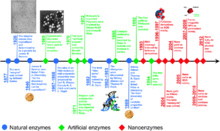
An interesting concept is that typically enzymes have been thought of as proteins that have catalytic properties. However, it would be very useful to have catalyst that is not damaged by heat, pH or other proteins that affect a typical protein. A science that is evolving is to create these novel materials that are different from enzymes in several ways: size, shape, structure, multiple functionality, and may also be tunable based on some other property.
This has also been called enzyme mimetics or enzyme mimics.
Several enzymes can be duplicated in function such as , Peroxidase, SOD, Catalase, Oxidase among others.
The materials that make these unique catalysts have ranged from unique molecules to nanomaterials to other common compounds such as Oxides (Cerium Oxide, Iron Oxide, Vanadium Oxide, Cobalt Oxide, Copper oxide among others), carbon based (Fullerene, Graphene, decorated graphene, carbon nanotubes and other carbon nanomaterials), Gold nanoparticles as well as unusual ones such as, Prussian blue, Metal organic compounds, Metal chalcogenides, metal hydroxides.
If these materials continue being developed then the next stage of drug discovery will be drugs that are artificial enzymes that catalyze reactions and make drugs that are low cost, easy to produce, robust, stable and tunable.